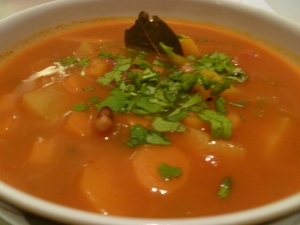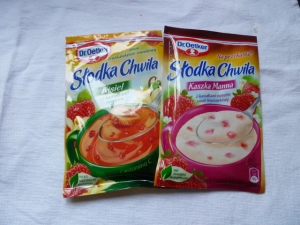Things are hotting up globally. Most of the Northern Hemisphere is experiencing unprecedented heatwaves, and things weren’t much different for the Southern Hemisphere back in their summer. On days like these, no one wants to introduce more heat into the home by turning on the hob. On the hottest days, it’s even too hot to light the barbecue, or grill, if you prefer.
This recipe has been inspired by both the summer heat, and a recent trip to Madrid, where we had Gazpacho or Salmorejo with almost every meal. I also really like a good Ajo Blanco, but sadly this isn’t the Big Guy’s favourite, so we have this less often.
It’s also the height of the growing season, and my garden is straining with all of the cucumbers that one single vine is currently churning out. There is nothing better, or more tasty than a freshly picked cucumber that has been gently warmed by the sun. I need something to do with them that isn’t slicing them for sandwiches or chopping them into a salad. Of course, I’m romanticising this simple fruit. If the only cucumbers you can get hold of come straight from the chiller cabinet in the supermarket, that will also be perfectly acceptable.
Today, I’m bringing you a light and refreshing no-cook cold soup. This recipe is also a bit of a freecipe, since it will be delicious no matter how much of each ingredient you have. Hot days are not meant for the constraints of weights and measures.
I also want you to feel free to change up the ingredients to suit what you have, and what you like. I guess the main elements of cucumber, yoghurt and herbs are required, but use whatever yoghurt you like – dairy or plant-based. I suspect it will be rather good with a tangy yoghurt made from goat milk, if that’s your thing. If you don’t like fennel, leave it out. If you have mint and basil instead of the herbs listed here, also fine. The chilling time can be substituted by a 10-minute blast in the freezer, by adding ice cubes to the soup, or a combination of both. It’s hot; just do what you like.
Freecipe: Chilled Cucumber and Fennel Soup
Serves: The amount I use here serves 4 as a light lunch or 6 as a starter. If you use fewer ingredients, your servings may vary
Prep Time: 10 minutes, plus as much chilling time as you have
Ingredients
A couple of large (English) cucumbers
Half a bulb fennel, core removed
A small bunch of herbs. I used parsley, dill, and tarragon. Any herbs of your choice will be good here
A small shallot, or about a quarter of an onion, or some spring onions
A garlic clove
Citrus juice to taste. I used the juice of half a lemon. Limes or finger limes would also work well. I suspect yuzu might be interesting. Experiment with whatever citrus in whatever proportions you have
Sunflower seeds or soaked cashews (optional). I chose not to use them in the version photographed here
Natural yoghurt, quark or fromage frais of your choice. Plant-based or the dairy version is up to you. Whichever you use, use the thickest version available, such as Greek-style yoghurt.
A good glug of the tastiest extra virgin olive oil that you have. I used about 5 tbsp for this amount of vegetables.
Salt & pepper to taste.
Method
Slice each cucumber in half lengthways. Remove the seeds by pressing a teaspoon into the pulp and running it down the length of each cucumber half. I set the pulp aside, and ate it with a spoon, having first sprinkled over a little salt, whilst waiting for the soup to chill.
Chop the cucumber, fennel, herbs, shallot and garlic as roughly as your best blender will allow. I have a high-speed blender, but you can also use a stick blender. If using a stick, you’ll probably need to chop the veggies a bit finer to start with.
I personally loathe raw alliums in my food, so I took some of the sulphur compounds away by pouring hot water from a fairly recently boiled kettle over the chopped shallot and garlic. I find this is less important if I were to use spring onions, and honestly, shallots are also much less pungent than their oniony cousins. Skip this step altogether if the raw onion thing doesn’t bother you.
Pulse blend everything you’ve just chopped, the citrus juice and the olive oil to break it down a bit before you add the yoghurt. Once the chopped stuff is broken down, add as much yoghurt or alternative as you want and blend it until smooth. Obviously, the cucumber will provide a lot of water. If you want a thicker soup, add more yoghurt.
For extra protein, and a thicker consistency you can also add neutral-flavoured nuts or seeds, such as soaked cashews or sunflower seeds. If you decide to use these, add them at the same time as the veggies and pulse alongside the rest.
Once everything is smooth, season well with salt and pepper. If you want to be fancy, use white pepper, so you don’t have black specks in your finished soup. Otherwise freshly ground black pepper will be just fine. Remember that the colder the soup is upon serving, the more seasoning you will need.
Chill for as much time as you have. Overnight is best to allow the flavour to develop, but if you haven’t been that organised, as I wasn’t today when I made the soup, make it when you decide you want it; it will be fine. Today I gave it four hours in the fridge. If you only decide that all you want to eat for the meal that’s pending right now is this soup, then give it a quick blast in your freezer, and/or lob a few ice cubes in at either the blending stage or into the finished dish, depending on whether or not your blender can cruch ice. You will need to compensate for the additional liquid with more herbs, citrus and yoghurt.
Serving Suggestion
How you serve this soup depends entirely on your context. For me today, it was a quick and cooling lunch when I was too warm to do much. I had it with some lovely crusty bread, some extra finely chopped cucumber and fennel and a few fronds of dill.
I always recommend an extra drizzle of the extra virgin olive oil that you used before. You could top it with another dollop of yoghurt, croutons baked with the same herbs that you used in the soup, and many other things. If serving for a particularly posh occasion, some edible flowers will be a pretty addition. Maybe you want to add a little chopped boiled egg. The beauty of a freecipe is that you can also garnish with whatever you feel is appropriate.
The only compulsory serving suggestion is that this dish is best served on a sunny day, having had the freedom of not needing to turn on any equipment that will add to the heat of the moment.
Storage
This cucumber and fennel soup will store well in the fridge for 3-4 days, so you can make it in advance if you keep an eye on the weather forecast.





























